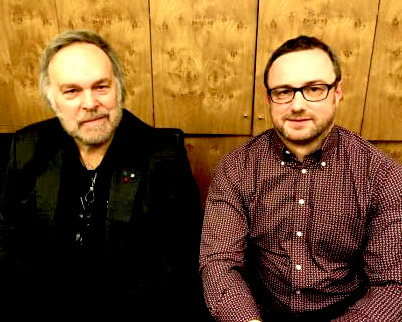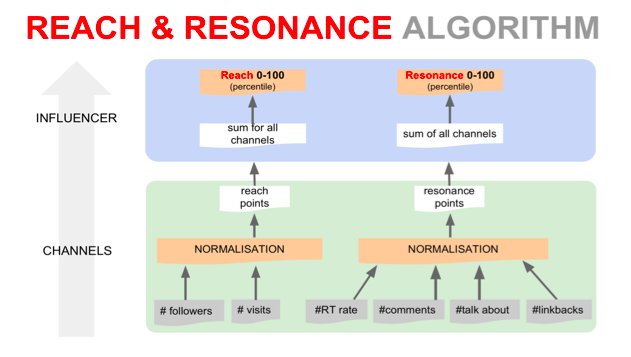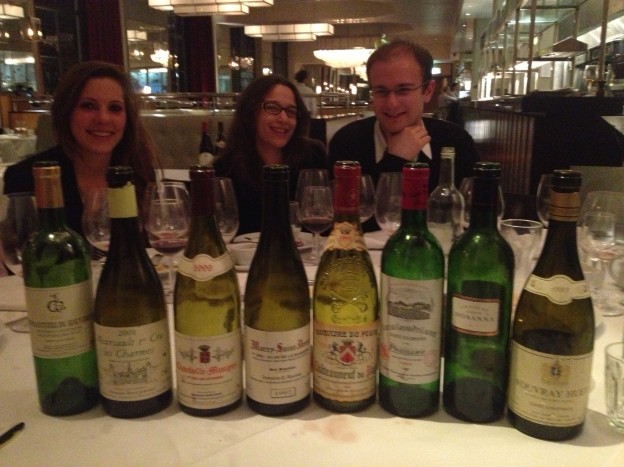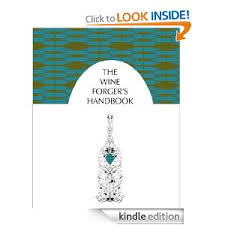by Wine Owners
Posted on 2015-03-16
With Robert Parker handing over the reins of Bordeaux Primeurs tasting to Neal Martin, what are the implications?
The first, most obvious, change is Neal’s palate.
However objective a critic may be, his or her palate and personal preferences inevitably play a big part. Where Parker excelled was at getting his impressions across in a particularly accessible and descriptive way; not easy when tasting barrel samples. The temptation is to describe a wine in its elemental state elementally, which isn't that interesting to read. He described its future, and over the years demonstrated he was rather good at that.
His personal preferences may have veered towards a sunnier style of wine, but he tended to let the wine buyer know if a wine was stylistically towards one end of the spectrum or another. But it must be very hard to award a great score to a wine that doesn’t move you viscerally, and to that extent personal preferences must come into play.
Martin’s tasting preferences are naturally more European than Parker’s, and is perhaps more likely to be dazzled by finesse and complexity over power, texture and rich fruit. This is a gross oversimplification for sure, but perhaps suffice to say his evaluations will be his own.
The second is winemaking trends.
The trend back towards a more classical form of winemaking is already underway (allied to far better vineyard husbandry than was broadly the case when Parker started out – he is often attributed with raising standards). Use of new oak is being moderated at many Chateaux, and régisseurs are looking at ways to fully express and nuance their amazing terroirs, sub-plots and micro-climates whilst making the most of Bordeaux’s inherent ability to bear and bottle the most age-worthy wines in the world.
The tendency of the late 1980s and 1990s towards making and showing the kind of wines proprietors thought would garner the best scores early on is on the wane. If the world’s leading critics and evaluators of young Bordeaux favour a finer-boned vernacular, this will be reflected in the market, which is more likely than not to reward those styles of wine with the greatest demand.
The third change is context.
Back in the early 1980s there was no Internet, market transparency was therefore limited and the market was much narrower than today’s. Can another critic, however good, assume the same degree of importance and purchasing influence over a market in the way that Parker has achieved? If so, will they come from Europe or do they have to be American? Or Asian?
Will crowdsourcing views and reviews become a proxy for the next leading critic of his or her generation, a perspective that arises with the growing importance of the Internet? I wonder. Some may argue that buyers are too ready in our online age to trust the word of a virtual room-full of complete strangers over the words of an advisor or friend. Whilst such principles may work well for holiday destinations or white goods manufacturers, it’s tougher to see how this will ultimately prevail for the finest of fine wine. How experienced is the taster, do they have a bank of reference points in respect of tasting young wines, and can they draw parallels between what a wine tasted like when in barrel compared with 10-15 years on? Can they recognise the future evolution of a young wine, see similarities and differences, then context (and visualise) the next young wine they taste accordingly? What does it mean when experienced tasters say that great wine is born great? What does great taste like? What’s the palate preference of each taster; where on the spectrum do they sit?
That’s an awful lot of questions to ask of a crowd, especially when most of them have day jobs. Broadly, people may not care about all that of course; but people into their fine wine, and making spending decisions based on the judgement of others, will care. That’s why evaluators of fine wine such as Neal Martin, Jancis Robinson, Stephen Tanzer, Antonio Galloni, Tim Atkin, Will Lyons, and many other talented writers (see here) matter so much.
What could be somewhat significant in turning reputation and influence into market impact is the business model deployed. What I wonder is this: with the Internet capable of coalescing huge audiences and showing the true - often massively underestimated - size of market niches, will blanket subscription firewalls allow wine writers to maximise market influence?
How experts in general monetise their high value content may yet change over the next few years, perhaps in a parallel way that the music business experienced a profound shift from selling records to selling bums on seats and festival tickets. Will the experiential become the bigger money-spinner? How the world’s critics engage with their audience and allow them an element of participation and dialogue may prove decisive for the next Parker, if there is to be one. Being social web savvy can only but help.
The fourth change may be the end to ‘wait and see’.
If the Chateaux knew Robert Parker was coming to Bordeaux, they might hold off from releasing until his scores were known, and the job of negociant and merchant alike was simplified, if sometimes a little delayed.
When Parker didn't come to town within a few months of the new vintage, the market reflected the collective views of the wine industry that had tasted samples most frequently (producers, courtiers, negociants, importers) and added a dose of realism to do with the macro-economic context. Price differentials within a set of wines (e.g. First Growths) were narrower. So, famously, 1990 was priced cheaply in the recession of 1991 as was 2008 in the post-Lehmann, financially sclerotic environment of 2009.
In the short term at least, all the leading critics will turn up to taste on time and publish on time. The extent to which they will collectively or individually influence prices (and demand) remains to be seen, but it would be more surprising if they didn’t have at least some bearing on the market. Producers are more likely to have made up their mind on pricing based on their qualitative assessments early on, and perhaps we shall all be spared interminably long campaigns.

by Wine Owners
Posted on 2015-02-13
The Traackr social media influence platform that we used for creating the wine writers and bloggers index elicited a fantastic range of comments, appropriately via social media on Twitter and Facebook.
Measuring writers personally based on their social media engagement across all platforms through which they engage their audience is a fresh way of looking at the world, which is precisely what makes it interesting.
So let’s dig a little deeper into how writer-centric, social media online measurement actually works:
As previously explained, Traackr’s algorithm is based on 3 parameters: Relevance, Reach and Resonance.
In the case of the wine writer and bloggers index, Relevance – the measure of expertise within the subject –scored highly across the board, as one might expect and the keywords used to determine this were necessarily quite broad.
The distribution of scores that reflect relevance were in fact tighter than Reach or Resonance, so this proved rather less of a discriminating factor than it otherwise might have done.
Subscription sites that put most content behind a firewall can’t be measured of course, since web crawlers and searchers cannot access them, so some of the most influential wine writers in the world end up with low overall scores.
Although their Twitter and social media accounts may well score well, blog posts and articles posted across online properties (which can be measured as long as sufficient article or blog text copy is available via RSS feeds) are heavily weighted by Traackr, so these influencers don’t show up as being key influencers through social media as they don't disseminate their content through it.
They may have significant influence over wine trade and consumer buying decisions, and consequently wine prices and the market, due to their experienced palates and authoritative wine evaluation and writing skills, but this is not what’s being measured when ranking by social media influence.
Reach measures the size of audience, based on numbers of followers and visits across all reach points. This measure focuses on the writer as an individual, and their free-to-air content whichever online properties they write for (as long as they can be personally identified).
That brings us to Resonance. This describes how much endorsement and engagement is being generated by a piece of content; every comment against blog entries or articles that are accessible free-to-air and available via RSS feeds, every talk about, tweet and retweet.
Those wine writers who outperformed their peers in the resulting list engaged powerfully with their audience, generated disproportionately high numbers of comments and talk abouts, along with tweets and retweets.
There’s something special to a consumer about having a dialogue with people who are expert in their subject area, or otherwise connecting with them online, and it’s to be celebrated. Of course it’s a different measure of influence when compared to the dissemination of paid for, advisory content through traditional media (whether online or not). Today, however, we proudly recognise the wine writing stars of social media and the social web across its many forms and the significant contribution they make, passing on their knowledge, guidance and passion to the many millions of people interested in wine.

by Wine Owners
Posted on 2013-06-11
The Wine Owners team had a BYO dinner at Cafe Anglais last month where we tasted some great wines. Here's the order of fare:
Les Plantiers de Haut-Brion Blanc Pessac Leognan 2007
Les Plantiers is a very limited production white from the young vines of Haut Brion and La Mission Haut Brion. It offers more than a hint of the style and quality of the Grand Vin, with a zesty and lively fruit appeal supported by good depth and minerality. Pure and balanced, long in the mouth, it will drink well on arrival but could also take five year's cellaring.
(90 points RP)
WO team view: White wine of the night. Taut, really long and pure, with at least a decade of life ahead.
Domaine Remi Jobard Meursault Charmes Premier Cru 2001
The superb, white flower-scented 2001 Meursault-Charmes splendidly combines breadth, depth, density, and concentration with focus, balance, and elegance. This intensely flavored wine is crammed with creamed minerals, limestone, chalk, and juicy spiced pears whose flavors can be experienced throughout its magisterial finish. (93-95 points WA)
WO team view: Showing why 2001 is such an extraordinary white burgundy vintage. The WA note reflects current reality perfectly.
Domaine Georges Roumier Morey-Saint-Denis Clos de la Bussiere Premier Cru 1997
Bright and scintillating if a little more backward than Roumier Chambolles. Gripping dark cherry and cherry stone fruit with touches of bramble and cassis wrapped in firm, defining fruit tannins. There is also a savoury mineral, stone and herb dimension, making this a very complex, complete Morey.
WO team view: Top of its game, and would have been a candidate for wine of the night were it not for..
Domaine Ghislaine Barthod Chambolle-Musigny Les Charmes Premier Cru 1999
The stunning 1999 Chambolle-Musigny Les Charmes is medium to dark ruby-colored and has an explosive blackberry, raspberry, and super-ripe cherry-scented nose. Medium to full-bodied, broad, and satin-textured, this is a superb wine that coats the palate with loads of cherries, violets, and candied black raspberries. Its perfumed, harmonious personality is feminine, expansive, and concentrated. Additionally, it reveals an exceptionally long, juicy, and delineated finish. It is the finest wine I have ever tasted from Mme. Barthod. Projected maturity: 2005-2014. (93-95 points WA)
WO team view: Not quite as boisterous as the deep, intense Morey. More to come in the coming few years.
Domaine du Pegau Cuvee Reservee Chateauneuf du Pape 1995
The 1995 Cuvee Reservee exhibits an opaque black/purple color, and extraordinary rich, intense aromas of smoke, black raspberries, kirsch, and spice. Exceptionally full-bodied, with an unctuous texture, and a thick, rich, expansive mid-palate, this superbly concentrated wine appears to be a worthy rival to this estate's phenomenal 1989 and 1990. This is a blockbuster Chateauneuf du Pape. Anticipated maturity: 2001-2020. (94 points Robert Parker)
WO team view: Perfectly mature, gamey and uniquely complex. Rich, sappy, utterly beguiling and moorish.
Chateau Grand Puy Lacoste Pauillac 5eme Cru Classe 1989
I absolutely love the nose on this wine, with amazing aromas of currant, tar, spices and berries that jump out of the glass. Loads of flowers, too. So complex. Delivers a full-bodied palate, with racy tannins and lots of flavor, from tar to spices to leather. A little tight, and so enjoyable now, but better in a few years still.’ (2010) (95 points, James Suckling)
WO team view: Wine of the night. Extraordinarily complex; it kept evolving in the decanter throughout dinner. GPL simply stomped all over Hosanna. No context, embarrassing really...
Chateau Hosanna Pomerol 2000
Dense ruby/purple, with a glorious nose of blackberries, cassis, white flowers, licorice, and a hint of sweet oak, this seamless wine is a classic example of purity and symmetry. A singular style reminiscent of a hypothetical blend of Cheval Blanc and L'Evangile.
(96 points, Robert Parker)
WO team view: Yeah it's good. Rich, deep, quite lingering, but made to look very ordinary by GPL 1989.
Domaine Huet Cuvee Constance Moelleux Vouvray 1993
The 1993 Cuvée Constance has a remarkably rich colour for any wine from Vouvray, belying the intensity of this nectar. The nose is remarkable, marked by aromas of rich golden syrup, with a whispering seam of botrytis which has a curiously dry suggestion, as does the nutty, caramel nuances that follow on. This is deep, complex and multi-faceted. Chris Kissack
WO team view: Lovely end to an amazing dinner, and not a single duff bottle. A sign of good fortune with which to toast the success of Wine Owners perhaps?

By the way, did you want to know the food that accompanied the wines? Thought not...
by Wine Owners
Posted on 2013-04-04
Fine wine is a multi-million dollar industry and is fraught with peril. From fake bottles to fraudulent contents, from mislabelled wine to misled consumers, wine has been faked, forged, and used for fraud for as long as it has been consumed.
This eBook provides a brief history of forgery and fraud in the fine wine world, including case studies on Rudy Kurniawan and Hardy Rodenstock, and is available from Amazon for just £1.53, or free to borrow and read on the Kindle for 'Prime' users.

The Wine Forger’s Handbook also functions as a guide, both on how fraudsters have been found out, and tips on how to avoid being fooled in your own wine purchases.
Written by a pair of award-winning writers, wine expert Stuart George and best-selling art crime expert Dr. Noah Charney, The Wine Forger’s Handbook is a fun, informative, engaging read, and one which could potentially save you from making costly purchases of fake wine.
The Wine Forger’s Handbook is ideal for anyone from wine collectors to casual drinkers, or those who enjoy true crime stories of forgery, deception, and detection set against the vivid backdrop of the world of wine.
ABOUT THE AUTHORS
Noah Charney
Noah Charney is a professor of art history specialising in art crime and a best-selling author of fiction and non-fiction.
His books include the international best-seller novel The Art Thief; the best-selling Stealing the Mystic Lamb: The True Story of the World’s Most Coveted Masterpiece; The Thefts of the Mona Lisa: On Stealing the World’s Most Famous Painting; and the guidebook series Museum Time. He is editor of Art & Crime: Exploring the Dark Side of the Art World and editor-in-chief of The Journal of Art Crime, the first peer-reviewed academic journal in its field.
He is the founder of ARCA, the Association for Research into Crimes against Art, an international non-profit research group on art crime and cultural heritage protection (http://www.artcrimeresearch.org/). He teaches art history and art crime on the ARCA Postgraduate Certificate Program in Art Crime and Cultural Heritage Protection at American University of Rome and for Brown University.
He is a popular speaker and recently gave a TED talk on art crime, which can be viewed at http://www.youtube.com/watch?v=T897Foh5s0g. He is an award-winning columnist for numerous magazines, with regular columns in The Daily Beast (http://www.thedailybeast.com/features/how-i-write.html), Tendencias del Mercado del Arte, and ArtInfo (http://blogs.artinfo.com/secrethistoryofart/).
He encourages readers to join him on Facebook (https://www.facebook.com/NoahCharney) or through his website http://www.noahcharney.com/.
Stuart George
Stuart George is an independent wine consultant in London.
In 2003 he was awarded the UK Young Wine Writer of the Year. Stuart was co-author of The Wine Box (2005), picture editor and leading contributor to 1001 Wines You Must Try Before You Die (2008), and editor of the award-winning The Finest Wines of Tuscany and Central Italy(2009) and The Finest Wines of Champagne (2009).
Stuart has contributed to publications on five continents, including The Daily Telegraph, Fine Wine International, Fine Wine & Liquor, Meininger’s Wine Business Monthly, Sommelier Journal, The Tasting Panel Magazine and the Times Literary Supplement.
He is a sought-after show judge and has been a jury member at wine competitions in Austria, Brazil, Chile, China, France, Luxembourg, Portugal and Spain. He has worked harvests in France, Italy and Australia.
His website and blog is at http://www.StuartGeorge.net/. He can be followed on Twitter at @sdgeorge1974.

